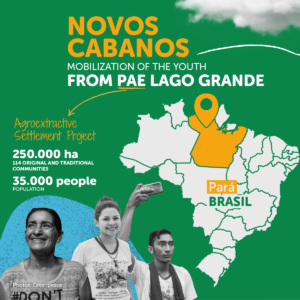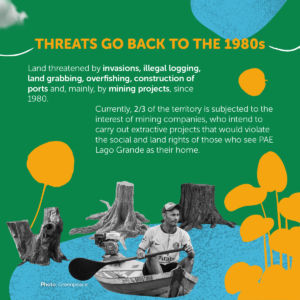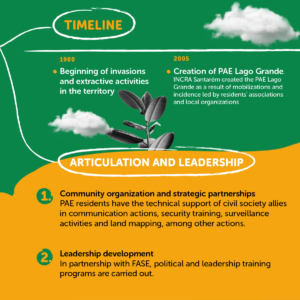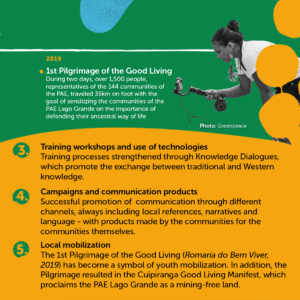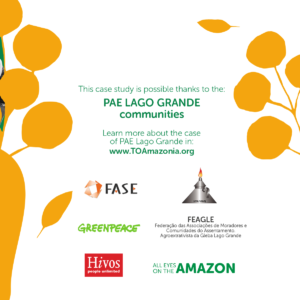Paths of Resistence – Case Studies Series
This case study shows how the local organizations of the Agroextractive Settlement Project Lago Grande (PAE Lago Grande), located in the state of Para in the Brazilian Amazon, promoted, in partnership with strategic allies, initiatives to engage the territory’s youth via processes of leadership training, mobilizations, campaigns, and communication, to empower and strengthen the fight against mining and extractive projects in their territory, having as a legacy the recovery of their ancestral memory of resistance.
1. Case Study Video
2. The Case Study in a Nutshell

3.1. Context and Challenges
Basic Information
Peoples: 144 traditional and original communities
Location: Municipality of Santarém, State of Pará, located in the Brazilian Amazon
Area: 250,344 hectares
Population: 5,736 families / approx. 35,000 people
Main activities: Traditional agriculture, fishing, animal husbandry and collection of forest products (extraction)
Local AEA partners involved: Federation of Associations of Residents and Communities of the Agroextractive Settlement of Gleba Lago Grande (FEAGLE), Rural Workers Union of Santarém (STTR) and Federation of Social and Educational Assistance Organizations (FASE-Amazônia)
- The Agroextractive Settlement Project (PAE) Lago Grande is located in the municipality of Santarem, in the State of Para, in the Brazilian Amazon, and is bathed by the Amazon (the largest in the world), Tapajos, and Arapiuns rivers.
- PAE Lago Grande consists of Arapixuna, Arapiuns and Lago Grande areas and is home to about 35,000 people of 144 traditional and native communities, such as riverine and indigenous people.
- The main threats registered in the territory since the 1980’s are related to invasions for illegal timber extraction and illegal land appropriation (land grabbing), besides predatory fishing, agrochemical use, port construction, and mining projects. The mining interest area covers approximately 150,000 hectares in the PAE region, or approximately ⅔ of the territory. Therefore, the territory, which already suffers the impacts of mining enterprises such as the concession to the Alcoa mining company, runs the risk of having even more breaches of its social and territorial rights and demographic swelling from these enterprises, given that the federal government is seeking to make the mining concession processes more flexible.
- Based on the talks and mobilization through neighborhood associations and unions, in 2005, the National Institute for Colonization and Agrarian Reform of Santarem (INCRA-SR/30) created the PAE Lago Grande through its Administrative Ruling No. 31/2005, transferring the land plots to the region’s traditional communities. However, INCRA has not yet completed the administrative processes to determine which areas within the PAE are private and which are public, which makes the collective titling arising from the execution of the Real Right of Use Agreement impossible.
- At present, there are several attempts to deconstruct the PAE as a collective territory, driven by the mining and agriculture sectors and by land grabbers. For instance, the update of the Directive Plan of the municipality of Santarem seeks to incorporate the PAE into the Agribusiness Expansion Area. In addition, the new Land Law of Para (Law no. 8,878/2019) favors the regularization of public areas illegally occupied1.
- The PAE dwellers are represented by the Federation of Associations of Residents and Communities of the Agroextractive Settlement of Gleba Lago Grande (FEAGLE), which is responsible for creating partnerships to ensure collective titling processes, the drafting of development and land-use plans, and the release of credits and incentives for infrastructure, housing, and production projects. Besides this, the region receives technical support of the Federation of Organs for Social and Educational Assistance (FASE-Amazônia), which promotes community organization initiatives, training, and communication initiatives, aiming at the sustainability of community leadership formation and political mobilization of the local population for the defense of the PAE Lago Grande territory, among other local and partner organizations.
- It is worth considering that the PAE Lago Grande region carries a strong identity legacy of Cabanagem, a popular and social revolt that took place during the Brazilian Empire between 1835 and 1840, in the region of the states of Para, Amazonas, Amapa, Roraima, and Rondonia. The landmarks of popular resistance have their impacts to the present day in the region, whose inhabitants rescue and translate this ancestral memory as an influence for their union and community organization. Thus, this case study presents strategies developed in partnership with the young people of PAE Lago Grande, self-called “new Cabanos”, to defend their territory through local mobilization and communication tools.

3.2. Strategies: key-factors to overcome the challenges
- Organization and strategic partnerships: Given its large territorial extension and the diversity of peoples and communities with a variety of cultures, customs, and cosmovisions, the main strategy used in PAE Lago Grande to coordinate demands and promote advocacy is community organization. Having as legacy the experience of collective resistance and community unity left by the Cabanagem uprising, the PAE communities are coordinated through several community organizations, which are the main responsible ones for mobilizing the inhabitants, structuring their demands, and promoting advocacy actions, whether political or through communication campaigns. Therefore, some of the local organizations present in the region are: Federation of Associations of Residents and Communities of the Agroextractive Settlement of Gleba Lago Grande (FEAGLE), Male and Female Rural Workers’ Union of Santarem (STTR-STM), Youth Pastoral (PJ), Mother Earth Group (Grupo Mãe Terra) and the Indigenous Council of Terra Cobra Grande (COINTECOG). Moreover, community organizations count on the civil society organizations and other institutions to promote specific actions, whether in communication and security training, or for territorial mapping and surveillance, among other initiatives. In this respect, the main allied organizations are: FASE-Amazônia, Federal University of Para (UFPA), Greenpeace, Artigo 19 and Witness.
- Leadership development: The territory of PAE Lago Grande is marked by its vast extension with scattered communities, with long distances between them. Therefore, successful community organization initiatives in the region need to be broadly disseminated, that is, they need to be implemented jointly with local organizations that have a wide presence in the territory. At first, this work was developed primarily in partnership with the region’s Male and Female Rural Workers’ Unions (STTR). However, about two years ago, the need to broaden this scope of mobilization was felt, also because of the need, in terms of the sustainability of their struggle, to renew the leadership of the unions and local organizations. In this regard, organizations operating in the region have focused their efforts on preparing young leaders in partnership with the Youth Pastoral (PJ), which has a strong and rooted presence not only in the PAE area, but also in the whole region of the Lower Amazon (Baixo Amazonas). Given the ideological current of Liberation Theology associated with the Pastoral, its young members usually bring a critical and politicized baggage on social justice issues, besides being used to coordination and mobilization initiatives – as an example, there was a significant increase in young leftist candidates in the last municipal elections (2020), an unprecedented factor in the region until then. Within this context, local organizations have promoted capacity building and leadership training programs in cycles that have the participation of approximately 60 young people and that address the impacts of mining in the territory and in the lives of its residents, including territorial defense strategies. In addition, this program counts on exchange activities for the PAE youth to exchange experience and knowledge with youth from other original or traditional territories, having contact with their respective territorial defense strategies. For instance, there were exchanges with young quilombolas and indigenous people in Espirito Santo, in territories affected by port construction, in addition to exchanges in Minas Gerais and in Para itself.
- Training workshops and use of technology: Another pillar of community organization involves the continuous training process promoted by local organizations jointly with civil society organizations, in a methodology of Dialogues of Knowledge, which consists of the exchange between traditional knowledge and academic/western knowledge, ensuring mutual learning between the communities and organized civil society. In this light, several training actions are carried out, mainly through capacity building workshops, on various topics such as integral security, communication, legal and juridical issues related to the PAE’s titling process, among others. In these spaces, young people study communication concepts and techniques and their political use – communication as a right and as a fighting tool to ensure their rights, for example. One of the aims of the communication workshops is for young people to assume the leadership of a sovereign communication, not being just receptors or observers of communication, but autonomous producers of their own stories, using their own language and narrative. In addition, the workshops seek to introduce the use of technology as a tool for territorial protection. In partnership with the NGO Witness, for example, young people learn how to use cameras and cell phones to record violations in their territory, gathering data that can be used for litigation or formal complaints. As a result of these workshops, the PAE communities benefit from communication products made by and for the communities. These contents include both traditional communication products, such as for social networks, TV, printed material, and radio programs, as well as products specific to their communities, such as little notes, letters, radios on poles, posters, and loudspeaker cars. Finally, it is important to highlight that the workshops add value to the young people in terms of knowledge about their extensive territory, in addition to strengthening community organization and unity, given that to participate in the communication workshops, they travel long distances, crossing rivers and getting to know new communities to meet colleagues they often only knew through social networks.
- Campaigns and communication products: Different strategies and means of communication are used, in a supplemental manner, to make the local population aware of the various threats existing in the PAE territory and, thus, provide the communities with data and information aimed at fostering community organization and territorial protection strategies. Given the amplitude of the PAE territory and the cultural variety of its inhabitants, local organizations use different tools to effectively communicate these messages to a diverse audience, taking into account the limitations of the region’s infrastructure and access to connectivity. – So, printed materials, audiovisual messages for social networks, and specific contents for WhatsApp, such as cartoons, among others, are produced. Moreover, every month FASE promotes a campaign, which includes billboards, cards, and written articles, mainly focused on the advocacy for social and territorial rights. Together, the tailoring of media content to the local reality, in terms of narrative and layout, and the fact that the content is produced and spread by community members, ensures the efficient communication of information to the whole community. Here, we highlight the example of Café Regional, a radio show also promoted by FASE that, by using local expressions and relaxed language, makes the diffusion of complex themes that impact the community accessible through a very popular means of communication in the region. Café Regional is broadcast weekly on community radio stations FM Lago, FM Novo Horizonte, and Radio Rural de Santarem, which is part of the Pan Amazon Radio Network. The strategy for designing the program was developed in three stages: Initially, it focused on winning the audience’s loyalty through a more ludic programming. At a later moment, also with the onset of the COVID-19 pandemic, the program started working with awareness and prevention topics, including a specific section on health that counted with the participation of health graduate students from the Federal University of the West of Para (UFOPA). At this stage, gradually introducing questions related to the impacts of mining was tried, besides dealing with the theme of rights protection, through programs with exclusively indigenous or quilombola themes, with participation of the Socio-Environmental Institute (ISA), the Indigenist Missionary Council (CIMI) and the Pastoral Land Commission (CPT) Currently, the program is preparing to start its third stage, which will be strongly focused on the impacts of mining in the PAE territory – although without losing the ludic narrative and the use of local language in order not to impact the accessibility of this information.
“Communications can be used in a popular way as an instrument of resistance, to bring back the memory of our history, to pass on our legacy from generation to generation, which has always been done orally. Communications are strategic in this. We want to have the autonomy to show who we are, who we were, and what we want to be. Knowing that we can use a cell phone camera to record violations is a big step. And today this is accessible. We can use these tools. Show that we exist and will resist!”
Ian Sousa Tavares, 19 years old, of the Arapyún people from the Camará Village, in the Sarambiá Indigenous Land
- Local mobilization: As a result of the liaison with local youth networks, the process of training young leaders, and the training workshops on political formation and communication, the 1st Pilgrimage of Good Living (I Romaria do Bem Viver) was held in November 2019, gathering 1,500 people (approximately 1,200 young people) in Santarem (state of Para -PA). During two days, representatives of the 144 communities of the PAE traveled 35km, in a route with five stops that had the purpose of making the residents aware of the importance of defending their ancestral way of life. The Pilgrimage was a historical milestone in the region with respect to the mobilization of youth to protect their territory, and also an opportunity for young people to apply in practice the knowledge gained in the process that started a year before the event took place. Thus, the young people were responsible for all the organization and coordination of the event, both in terms of logistics, agenda, fundraising, and coordination with local communities, and in terms of communication products, promoting all the coverage and publicity materials about the event. In addition, the Pilgrimage resulted in the Cuipiranga Manifesto for Living Well, which defends PAE Lago Grande as a territory free from mining. Besides being a symbol of popular mobilization of the youth, the event was also valuable for uniting even more diverse communities in the territory, while it also sought to rescue the legacy of the Cabanagem uprising resistance in the region. During the Pilgrimage, the young people performed activities to map their ancestry and identify which of their ancestors were Cabano rebels – this activity is closely linked to the appreciation not only of their history, but also of the sacred elements of the territory, since the PAE is home to a Cabano cemetery. Thus, the Cabanagem uprising is reinforced as another element of union and identity among PAE youth.
3.3. Benefits: added value and case impacts
- Rescue of community identity and unity: One of the greatest legacies of the liaison process with the youth was, without a doubt, the rescue of the Cabanagem ancestry and its nature of resistance in the region, which is currently a major identity link that unites the PAE communities even more. The recovery of this process serves not only to unite the youth, but also gives dimension to the long process of threats faced in the region, while further connecting the youth to their territory, including the appreciation of historical sites such as the Cabano cemetery. This rescue process, intensified by ancestral mapping activities such as the one promoted during the I Pilgrimage of the Good Life, has strongly contributed to the empowerment of organized youth in the region, who currently call themselves the “New Cabanos.”
- Leadership renewal: Identifying the need to involve youth in community organization initiatives is one of the most successful strategies employed by the local organizations of PAE Lago Grande. From this involvement, mainly through the Youth Pastoral (PJ), the territorial protection initiatives have been substantially strengthened, precisely because they are carried out from an already existing network, with a pervasive and rooted presence in the territory and, therefore, with a high ability for mobilization Besides fostering popular mobilization, the initiatives for leadership training and capacity building in politics and communication for youth allowed for the renewal of community leaders, who are now even more equipped to pursue the fight for the protection of the PAE territory. An example of the politicization and engagement of this youth is found in the Cuipiranga Manifesto for Living Well, which wraps up with the following commitment: “For the memory of our Cabano ancestors we UNDERTAKE to fight in order to protect our territory for the propagation of our ways of life, securing collective titling, because collectivity is the historical hallmark of our people.”
- Communication and territorial reach: In the PAE Lago Grande territory, communication is used both as a strategy and as a tool to fight for the protection of the territory. In a territory of more than 250,000 hectares with great social and cultural diversity, it is a particular challenge to identify which tools, languages and media are the most suitable for delivering information to the inhabitants. In this respect, the local PAE organizations were very successful in promoting communication strategies based on complementary media (traditional and local), always using local references, narratives, and language. The successful outreach of these materials is also due to the fact that they are produced by people in the territory for the people in the territory. These strategies are mainly important to convey the risks of mining – where mining is already present, communities know the magnitude of its impacts on their territory and their lives, but the other communities (target of mineral exploitation) are not necessarily organized to resist these impacts and avoid violations in their territory. Therefore, culturally adapted communication also fulfills the role of informing, training, and preparing these communities to resist against the presence of mining or other extractive activities with social and territorial impacts that may violate their rights.
4. Timeline
Know more about:
Videos
- FASE: Utilization Plan for the Agroextractive Settlement Project (PAE) Lago Grande (2016) [Plano de Utilização do Projeto de Assentamento Agroextrativista (PAE) Lago Grande]
- Witness: PAE Lago Grande – The Amazon (2019) [PAE Lago Grande – Amazônia]
- Mining in PAE Lago Grande (2021) [Mineração in PAE Lago Grande]
- Entre Várzea e Terra Firme Lago Grande do Curuai: The threats to PAE Lago Grande due to the operation of the Alcoa mining company (2018) [As ameaças ao PAE Lago Grande pela atuação da mineradora Alcoa]
- Witness: Living-Well Pilgrimage – PAE Lago Grande (2019) [Romaria do Bem Viver – PAE Lago Grande]
- Greenpeace: Living-Well Pilgrimage (2019) [Romaria do Bem Viver]
- Living-Well Pilgrimage (2019) [Romaria do Bem Viver]
- #1 Living-Well Pilgrimage (2019) [#1 Romaria do Bem Viver]
- PJ Arquidiocese de Santarem: 1st LIVING WELL PILGRIMAGE (2019) [I Romaria do Bem Viver]
- TV Lamparina: With clapping and loud cheering leaders of PAE Lago Grande sing the STTR Hymn (2016) [Com palmas e em alta voz lideranças do PAE Lago Grande entoam o Hino do STTR]
Files
- PAE Lago Grande Utilization Plan (2018) [Plano de Uso PAE Lago Grande]
- Cuipiranga’s Manifesto for Living Well (2019) [Manifesto de Cuipiranga pelo Bem Viver]

